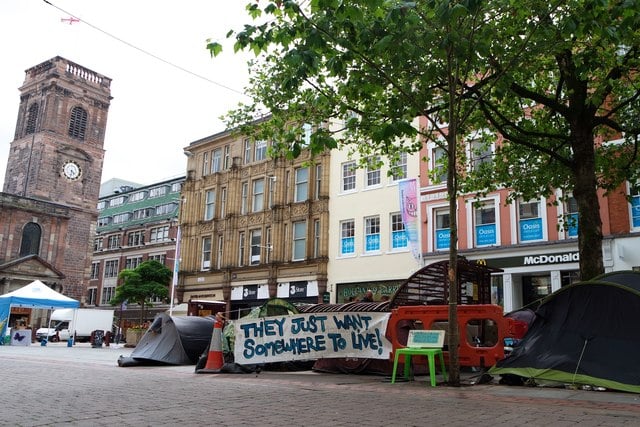Erasing the invisible: Homelessness in Manchester
April 10, 2016

Photo Credit: Matt Harrop
Manchester. A city of unmatched musical and footballing heritage, its reputation for which greatly exceeds its size. But underneath the music and the football chants resonating from either side of the city are the sounds of a desperate world, hidden from view and cast into social oblivion. A world all too often stereotyped, victimised or simply ignored by society, the world of the invisible – the homeless.
As a society, we have been extremely lucky. We have managed to match a few numbers in the lottery of life and have our feet planted firmly on the shores of one of the richest countries in the world. Consequently, we take many of the luxuries we have for granted, and rarely question the fallibility of the system which provides them. The reality is of course that any one of us could find ourselves on the wrong side of the socioeconomic bubble, living out of carrier bags while our pleas for spare change are swept away upon the winds of apathy.
The number of people suffering behind the shroud of indifference in the UK is on the rise, more than doubling nationally since 2009/2010. In Manchester, statistics regarding rough sleepers have revealed that the situation in the city is even more bleak than in much of the rest of the country. The city centre has witnessed a staggering tenfold increase in rough sleepers over the same period, with an estimated 70 people sleeping rough on any given night.
But the accuracy of these estimations come into question when we consider the way in which the rough-sleeping ‘snapshot’ is determined according to government guidelines. People found in the open air (on the streets, in tents, doorways, parks, bus shelters and encampments), or in enclosed spaces which are unintended as a dwelling (car parks and stairwells), are only considered as part of the figures if they are sleeping on, or are about to ‘bed down’ in, their bedding. Those wandering the streets or absent from their patch are subsequently excluded from the numbers, meaning precise figures could be much higher, with many unrecognised ‘hotspots’ potentially being missed. Similarly, the individuals who are in temporary accommodation such as homeless shelters and hostels, of which 50% are young people aged between 16 and 24, are also omitted.
To highlight the scale of the misrepresentation, in 2014 the official report claimed there were approximately 26 rough sleepers in the city centre. However, following a more in depth inquiry by Manchester council, who compiled reports from the homeless organisations in the area, the figure was determined to be around 150 people – six times higher than official reports. Therefore, the current number of rough sleepers in Manchester could theoretically be as high as 360 individuals.
The current situation works in the government’s favour in two ways. Firstly, by downplaying the true extent of the issue through misrepresented figures, the wolf is able to maintain its sheep-like appearance and deceive the public into thinking the issue doesn’t exist. Secondly, by reducing funding to local government, any inability to handle the added pressure on local services is automatically regarded as the incompetence of the council and not central government. This way of diverting accountability away from central government is a very crafty game of political point scoring.
With such skewed data regarding real numbers of those living homeless in Manchester, it begs the question – how can we be providing sufficient support and relief services to people who, according to the numbers, do not exist? This is just one problem faced by those attempting to provide these services, as unscrupulous cuts to local government funding fly in the face of the empty promises of a prosperous North and a truly devolved Manchester. Councils are thus experiencing greater difficulty in mitigating the consequences of the political ideologies being imposed on our society. The prevalence of welfare cuts, high rents and stagnated wages are forcing people into poverty and homelessness. Add to this the fact that the lack of central funding will inevitably lead to an increase in council tax. Increasing living costs through taxation to pay for local services will act a double edged sword, cutting the foundations from under the feet of many more people, potentially leading to a further increase in homelessness.
Although there are homeless strategies in place in Manchester which offer a multifaceted approach to challenge and prevent occurrences, it is tempting to question their effectiveness. Poverty and homelessness are indications of any society’s socioeconomic health, in the same way that cracks help determine the condition of a wall. The strategies employed can only really paint over the cracks, rather than address the physical issue and re-plaster the entire wall. Unfortunately, the latter is discordant with the government’s primary agenda; instead, they have kindly offered an extra £500 million to help with the re-painting costs.
Ultimately, rough sleeping is just the tip of the iceberg, with estimates of 100,000 people across the country considered as homeless in one form or another. The old and infirm, the mentally ill, the young, families, and adults with dependants, will continue to get priority help. But as these services are pressed to their limits, the number of people spilling over the brim onto the streets will continue to rise.
As the cracks continue to grow, and the paint begins to run out, how far will it go and what happens then? Not just to society, but to the people having to face the indignity of social exclusion while their plight is left to patchwork policies.
Let’s just hope they don’t mind the colour blue.

Comments